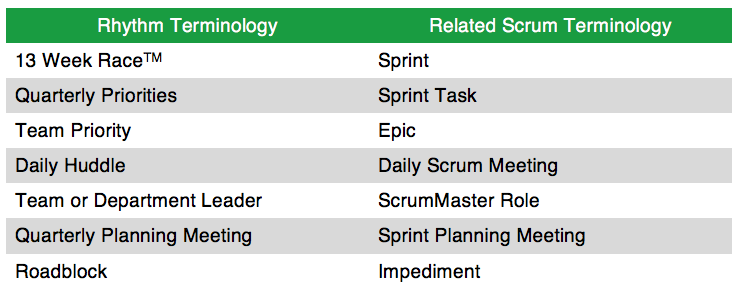What is Scrum, and why do I care? Scrum is a term that has moved from the discussion in the server  rooms and development area of organizations and is slowly making its way to the boardrooms. This has caused some confusion on a few executive teams that I work with that are unfamiliar with the Scrum Agile methodology and wonder how it ties in with Rhythm. I hope to clear up some of that confusion with this post and inform you on how these methods can work together to achieve breakthrough execution.
rooms and development area of organizations and is slowly making its way to the boardrooms. This has caused some confusion on a few executive teams that I work with that are unfamiliar with the Scrum Agile methodology and wonder how it ties in with Rhythm. I hope to clear up some of that confusion with this post and inform you on how these methods can work together to achieve breakthrough execution.
Scrum was originally designed to be used specifically for software development teams to have them “ship early and often” to get useful software into the hands of customers more quickly. You can read some thoughts on that in my previous blog post “9 Tips to Make Your Business Agile and Outsmart the Competition” to find some tricks of the trade. The process has been so successful in transforming software development, it is now used across other business activities in order to manage complex projects.
What is Scrum?
Scrum is an agile framework for managing large, complicated projects. The basic tenet of Scrum is that you take a large, seemingly insurmountable, project and break it down into manageable bite-size chunks of time, called sprints. Each sprint is designed to take a certain number of components of the project and complete them within the time frame. Sprints in the software world typically last four weeks and the end of each sprint concludes with a version of the software that can be shipped to customers. Sprint time boxes are typically longer with business management teams, generally a quarter, although some tasks will be completed more quickly.
The Rhythm strategy execution software and methodology work extremely well within the Scrum framework. Our methodology breaks down large projects, such as your Annual Plan, into four Quarterly Plans that we call the 13 Week Race™. Since sprints, by definition, are shorter than typical business planning timeframes, we should be able to accurately predict what we’ll be able to accomplish. As an example, some businesses have relied almost exclusively on annual plans, even though business conditions change many times during the year. Breaking the year into four quarterly sprints allows you to more accurately plan what the team will be able to accomplish in the first quarter. At the end of the first quarter, you’ll readdress the market and make a plan for the second quarter, which you’ll be able to more accurately estimate at the end of Q1 than the start of Q1 as you have thirteen weeks of actual data. These 13 Week Races are analogous to sprints as they are time boxes with a clear set of deliverables attached. Like shorter sprints when team planning? Our software and methodology easily adapt to those time frames as well.
How do I keep my team aligned? Or who acts as the ScrumMaster in Rhythm?
In the Scrum software development framework, every team has a ScrumMaster, whose job is to keep the team aligned, on task, and to remove roadblocks and impediments. In Rhythm, we utilize team leaders (the most effective are typically Rhythm Certified Leaders) that perform many of the same duties as the ScrumMaster. They work as an interface for the department with the executive team to remove any roadblocks and promote cross-departmental collaboration, information sharing, and coordinate interdependencies.
The Rhythm Methodology also employs a daily huddle, just like Scrum’s daily stand-up meeting, to make sure that team members are able to connect every single day to stay on the same page. This quick check in keeps everyone aligned and updated with the latest information and provides quick access to the team to remove any impediments. These meetings are short and last no more than 15 minutes.
We also have Weekly Adjustment Meetings to drive execution against your strategic plan. Each sprint, or 13 Week Race, has a retrospective meeting in the Quarterly Planning session to review what has worked and what can be improved when creating the set of priorities for the next quarter. Scrum has a similar function in its framework, called a retrospective, that takes place at the end of each release. These meetings serve as a way to take all of the information that we learned during the last sprint, repeat what has worked, and eliminate anything that wasn’t productive. This planning rhythm allows teams to use the most up to date information to prioritize their initiatives and clearly define what success would look like at the end of the next sprint.
How do I know what to work on next? Or who owns the product owner role in Rhythm?
Scrum has a product backlog that is maintained by the product owner. This is a list of all of the new features that the market wants in the software, prioritized in order of importance. In Rhythm, we have a similar project list, called Quarterly Priorities, that is maintained by the Team Leader and is influenced by the company goals to achieve the desired business results. These projects are the top 3-5 growth initiatives for the company and team for the quarter. They are prioritized based on business impact and all have a clear set of success criteria defining the objective of the priority. The team leaders typically are in charge of the Meeting Rhythms - the Daily Huddle, Weekly Adjustment Meetings and appropriate Planning Sessions. They work directly with the team to keep the projects properly prioritized and ranked on the Rhythm Systems dashboard.
How do Rhythm and Scrum work together?
First and foremost, the two systems aren’t mutually exclusive and work well together. Rhythm can be the software of record that holds all of the different priorities for all of the different departments in a single place. This helps track all of the initiatives across the organization from the latest marketing campaigns to the retooling of the shop floor with easy to interpret visual dashboards to track progress and facilitate cross-departmental collaboration. Each of these departments have their own tools that they would use to track the details of their efforts - Salesforce, Excel, Microsoft Project, Jira and many more - and use Rhythm to update others across the company.
Agile Business Planning: Utilizing Agile Business Model for Growth
As you can see, Rhythm and Scrum can work in tandem to keep your business team aligned, prioritized and focused. Rhythm should be used to keep a high-level view of the major releases and initiatives across your organization and to facilitate the cross-departmental collaboration needed to support a release - such as marketing’s role to promote the new features. The details, storyboards, personas, and other technical details can live within the current software the development team is using while updating all of the other teams through the centralized Rhythm software that provides dashboards for all of your organization’s teams.
Ted Skinner
Interested in Scrum? Agile Business Planning: Utilizing Agile Business Model for Growth
Photo Credit: iStock by Getty Images





